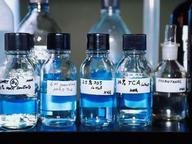Quiz Answer Key and Fun Facts
1. Let's begin with the hydroxide of a light, silvery white metal; one that often reminds me of German lye rolls. With a colossal global demand, this basic compound finds vast use in petroleum drilling and in the removal of sulphurous impurities from sub grade crude oil. In solution form, it is employed for separating lignin from cellulose fibres in wood pulping for manufacturing paper. Vital to soap production, it is widely used as "caustic" in industries during cleaning processes. Which of the following compounds am I describing?
2. Next in line stands a crystalline, hygroscopic solid, the weakest among all alkali metal hydroxides. This fellow is a favourite in air purification systems in space capsules, where it is employed for absorbing carbon dioxide and accommodating more oxygen for breathing. Its light weight here is additionally an advantage in reducing the craft's launching weight. Identify this base, which is widely used in making greases, and as an electrolyte in electrical storage batteries.
3. Practically a household name today, this base finds utility in medical science as an antacid for curing heartburn and acid indigestion. This compound is used in fire extinguishers for controlling minor fires sparked by electricity and for removing paint and corrosion from the surfaces of metallic items. Its use in bakery for the leavening of bread lends it, among others, the name "bread soda." What is the compound in question?
4. Sulphuric acid, the 'Oil of Vitriol', is prepared industrially by the Contact Process. The amphoteric compound catalyses the high temperature oxidation of sulphur dioxide to sulphur trioxide in this process. The most industrially important oxide of its parent metal, it is also useful as a catalyst in the preparation of oxalic acid, adipic acid and acrylic acid. What is this sparingly soluble, (generally) yellow solid?
5. The next chemical specie is actually an aqueous solution of a basic gas. Its most popular use is as a cleaning agent - both singly and as a part of more complex cleansers, for removing grease from windows or ink spots from clothes. Its alkaline properties make it an effective antimicrobial agent and an acid regulator. The cosmetic industry often employs it for producing hair dyes and hair bleaching products. Which of the given compounds is this?
6. Available in the solid mineral form as brucite, this compound is mildly basic. It exhibits a milk like appearance when in the suspension form, which gives it a well known common name. In this suspended form, it is used in medical science as a laxative and an antacid. Which base is this, a highly significant component of structural materials used to build artificial coral reefs for the preservation of aquatic lifeforms?
7. Some bases are more suited for chemical analysis than others due to some unique chemical advantages. The compound under discussion is widely used in a qualitative test for verifying whether an organic compound is unsaturated. The property exploited here is its strong oxidising nature. Named after a German organic chemist, it is, chemically, cold and dilute alkaline potassium permanganate. By what name do we know this purplish pink reactant?
8. Next in sequence is a white, water soluble base which, due to its hygroscopic nature, is used as a mild drying agent for specific requirements. It was initially used to prepare "pearl ash," a leavening agent often used before baking powder came to the fore. It plays a major role in preparing certain types of glass and in helping to soften hard water. In our body processes, its helps maintain ionic equilibrium in sensory cells of the nervous system. Identify this base.
9. Besides such entities, a number of biological bases operate inside our body, contributing to the body structure and to cellular metabolism in different ways. One category of biochemicals includes "nucleobases." These are nitrogenous bases attached to a sugar group and a phosphate group in nucleotides, the building blocks of DNA and RNA. Genes in the DNA strands decide an individual's hereditary traits. Which of the four given nucleobases is NOT found both in DNA and RNA?
10. Lime is a commercial chemical of widespread industrial use, notably as a crucial ingredient in manufacturing cement. This is the chemical that lent its name to "limelight", the popular form of theatrical lighting before electrical illumination developed. It is used as an instant source of energy, obtained through its hydration, and in the production of biodiesel. How "quickly" can you tell me the subject of the gossip?
Source: Author
Trent500
This quiz was reviewed by FunTrivia editor
rossian before going online.
Any errors found in FunTrivia content are routinely corrected through our feedback system.
